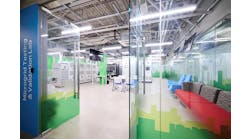The Pandemic May Accelerate the Arrival of the Lights-Out Data Center
Today we conclude our Data Center Executive Roundtable, a quarterly feature showcasing the insights of thought leaders on the state of the data center industry, and where it is headed. In today’s discussion, our panel of data center experts discuss the future of data center automation, and how it is being shaped by the COVID-19 pandemic. Our panelists include Angie McMillin from Vertiv, Kevin Facinelli from Nortek, Phillip Marangella of EdgeConneX, CoreSite’s Juan Font, Digital Realty’s Tony Bishop and Jaime Leverton from eStruxture Data Centers and Infrastructure Masons.
The conversation is moderated by Rich Miller, the founder and editor of Data Center Frontier.
Data Center Frontier: The COVID-19 pandemic is prompting companies to pursue automation to limit health risks. What are the most promising innovations the data center industry can adopt to meet the challenges posed by the pandemic?
TONY BISHOP, Digital Realty
Tony Bishop: Automation is at the heart of everything data centers are doing to ensure business continuity, especially now. As the world quickly transitioned to remote work/business, the stress on our IT infrastructure increased dramatically. Data centers emerged as critical resources for keeping our digital economy running, yet they too needed to re-evaluate normal operations to keep employees, customers and partners safe. Automation has evolved from a tool to give operators more time to concentrate on complex tasks that may require higher level skills for human intervention, to a lever operators can pull to ensure the health and safety of employees.
Predictive maintenance is also on the rise as a health and safety tool as data centers turn their attention to next-gen data center infrastructure management capabilities to extend remote monitoring and management capabilities, enabling customers, partners and team members the ability to improve flexibility and enable remote work when needed.
Finally, we’re also seeing companies like IBM investing in hybrid connectivity to enable customers to be successful, no matter where their data is located. The post-COVID enterprise will need to be more strategic about where their data lies. With hybrid strategies, they can not only increase their agility, but adapt quickly and ensure business continuity if or when something like a pandemic disrupts normal business operations in the future.
JAIME LEVERTON, iMasons and eStruxture Data Centers.
Jaime Leverton: The Covid-19 pandemic is at the same time disruptive and driving innovation in the way we, as data centers operators, manage our facilities. We are now talking about software-driven data center automation and AI applications that enable remote data center management. Monitoring and automation enable a data center to run with minimal or no staffing on site during crises such as the present one. This allows us to have some of our staff work remotely, as well as minimize customer and vendor foot traffic.
Even as the economy reopens from lockdown, the data center industry will continue to look for new and better ways to use remote management and perhaps soon the “lights-out data center,” where everything is fully automated, could become the new standard.
KEVIN FACINELLI, Nortek Air Solutions
Kevin Facinelli: COVID-19 has also put a new emphasis on working remotely and automation. Limited travel and fewer administrator data center onsite visits have given a new value to cooling equipment that’s fully automated. Automatically switching cooling modes, especially with indirect evaporative equipment, can save significant data center operating costs in both water and power. This type of equipment’s built-in control strategies react automatically within minutes to hundreds of programmed outdoor ambient scenarios to provide optimum energy efficiency. These systems also cool the majority of time without the use of traditional, energy-intensive chillers. However, trim chilling, if available, can automatically be employed a few days annually when worse-case outdoor conditions occur. This automation can be programmed for optimum sustainability and synergy with building management systems.
Therefore in a time and place like today where manual operator intervention may not be as convenient, cooling equipment automation is luckily state-of-the-art. An operator might mistakenly believe that the BMS can be programmed to provide this type of pinpoint control, but no two buildings are alike. A data center cooling system with a sophisticated onboard control strategy can successfully navigate the tremendous amount of routine environmental variances directed toward the operator. It can simplify or filter them down to just critical tasks. This helps simplify data center operations that have become complicated with COVID-19.
PHILLIP MARANGELLA, EdgeConneX
Phillip Marangella: Data center automation and “lights-out” facilities are definitely becoming more critical as those who work in a data center can no longer travel. Being able to remotely monitor and manage your workloads is absolutely necessary to give customers peace of mind and be able to continue their business operations with zero downtime.
Having a DCIM platform that can provide the customer with those remote capabilities is key during COVID-19, but it will also create a new normal as data center managers become more comfortable and experienced in remotely managing workloads.
Juan Font: Access to data centers as much as any other workplace environment has been severely impacted by COVID-19. Early on in the pandemic, we saw a dramatic reduction in customer visits to our own data centers. Thankfully, CoreSite had been investing for a long time in building robust, lights-out capabilities. This is principally enabled by our 24×7 remote hands capability, having our own Data Center Operations teams staffing the sites 24×7 (including throughout the pandemic), as well as by the enhancement to the MyCoreSite Customer Portal over the years.
For example, aside from being able to interact with CoreSite for any sort of requirement, like adding power, shipping and receiving, etc., customers can also use the portal’s Data Center Intelligence features to check real-time environmental data, such as power usage, temperature and relative humidity at the rack level or security access logs into the customer space. The advent of the pandemic has really brought to the forefront how important it is to our customers that CoreSite becomes a true extension of their operations, and we’re very proud of being able to deliver on that front.
ANGIE McMILLIN, Vertiv
Angie McMillin: The pandemic is going to accelerate the move to lights-out data centers. One of the innovations we can expect as part of this evolution is increased integration between building management, data center infrastructure management and IT management systems. Enabling collaboration across these systems will enhance the value of each system and support the move to more predictive management that delivers better performance at lower cost.
RECAP: Links to all the Roundtable articles and Executive Insights transcripts for all our participants.
Keep pace with the fact-moving world of data centers and cloud computing by following us on Twitter and Facebook, connecting with me on LinkedIn, and signing up for our weekly newspaper using the form below:







